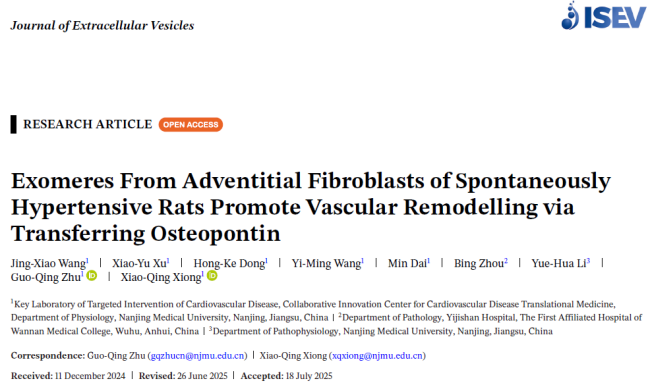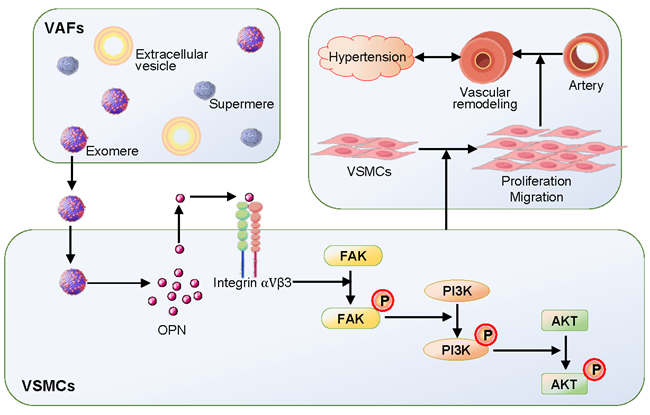Recently, the research team led by Professor Guoqing Zhu from the Cardiovascular Laboratory, Department of Physiology, School of Basic Medical Sciences, published a research paper in the Journal of Extracellular Vesicles titled "Exomeres from Adventitial Fibroblasts of Spontaneously Hypertensive Rats Promote Vascular Remodelling via Transferring Osteopontin". The study revealed that adventitial fibroblasts of spontaneously hypertensive rats release exomeres (EMs) that transport osteopontin to activate the integrin αVβ3/FAK/PI3K/AKT signaling pathway. This process promotes the proliferation and migration of vascular smooth muscle cells, driving vascular remodeling and exacerbating hypertension. These findings highlight the critical role of EMs in hypertension and vascular remodeling, and suggest that targeting osteopontin and EMs in blood vessels may offer a potential therapeutic strategy for alleviating vascular remodeling in hypertension.

EMs and supermeres (SMs) are two recently discovered non-vesicular extracellular nanoparticles (NVEPs) with important intercellular communication functions. Unlike extracellular vesicles (EVs), EMs and SMs lack a lipid bilayer membrane coating, and the particle diameter is smaller. The cardiovascular pathophysiological effects and underlying mechanisms of NVEPs remain unclear. Based on the team’s previous exploration of the role and mechanism of EVs in vascular remodeling in hypertension, this study is the first to isolate EMs and SMs from adventitial fibroblasts, and to compare and characterize EVs, EMs and SMs.
It was found that EMs released by adventitial fibroblasts in spontaneously hypertensive rats play an important role in the proliferation and migration of vascular smooth muscle cells, vascular remodeling and the pathogenesis of hypertension. Mechanistically, EMs deliver osteopontin to activate the downstream integrin αVβ3/FAK/PI3K/AKT signaling pathway. Osteopontin alleviates vascular remodeling in the affected regions of hypertensive animals, whereas long-term intravenous administration of EMs from SHR aggravates vascular remodeling and hypertension. These findings identify EMs and osteopontin as promising targets for therapeutic intervention in vascular remodeling in hypertension and provide a new theoretical basis, experimental foundation and strategic insights for its prevention and treatment.

Professor Guoqing Zhu and Associate Professor Xiaoqing Xiong from the Department of Physiology, School of Basic Medical Sciences, NMU, are the co-corresponding authors of this paper, and Dr. Jingxiao Wang is the first author. This research was supported by the National Natural Science Foundation of China, Postgraduate Research & Practice Innovation Program of Jiangsu Province, and the Collaborative Innovation Center for Cardiovascular Disease Translational Medicine.
Link to the original paper:
https://isevjournals.onlinelibrary.wiley.com/doi/10.1002/jev2.70146
(Drafted by Guoqing Zhu’s Research Group; Reviewed by Feng Chen and Juejin Wang; Translation revised by Bei Zhang)



